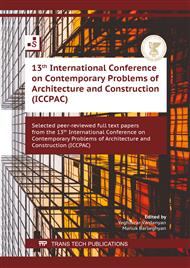p.43
p.51
p.59
p.65
p.73
p.79
p.85
p.95
p.115
Study of the Characteristics in the Problem on the Stress State of a Piecewise Homogeneous Half-Space at an Antiplane Deformation in the Presence of Stress Concentrators of the Type of Cracks and Stringers
Abstract:
This paper considers the problem of the mathematical theory of elasticity on the stressed state of a piecewise homogeneous half-space at an antiplane deformation in the presence of stress concentrators such as cracks and stringers. The piecewise homogeneous half-space consists of an elastic layer and an elastic half-space with different shear modules. The arbitrary finite number of collinear system of tunnel cracks is located at the joint line between the layer and the half-plane, and the upper edge of the layer is reinforced by an arbitrary finite number of collinear system of stringers. It is assumed that under the action of tangential forces applied to the crack faces and stringers, the piecewise homogeneous half-space is in the conditions of antiplane deformation (longitudinal shear). Such problems arise in research in structural mechanics, geomechanics, geophysics, measuring technology and other areas of applied mechanics and engineering practice. Using the Fourier integral transformations, solving the described problem is reduced solving a system of SIE systems. Based on the solution of these systems, important characteristics of the problem such as the dislocation densities on the crack edges, crack opening, breaking tangential stresses outside the system of cracks on their line, stress intensity coefficients (SIF), tangential contact stresses under the stringers are determined. These values are represented by explicit analytical formulas that are convenient for practical calculations. Particular cases are considered.
Info:
Periodical:
Pages:
85-94
Citation:
Online since:
February 2022
Authors:
Price:
Сopyright:
© 2022 Trans Tech Publications Ltd. All Rights Reserved
Share:
Citation:


